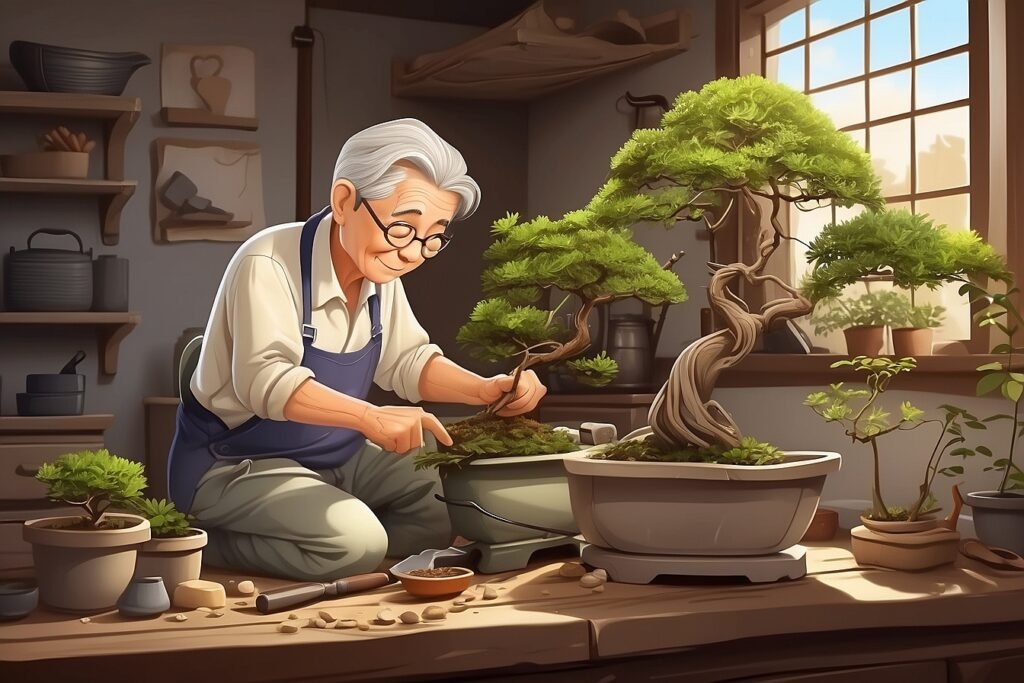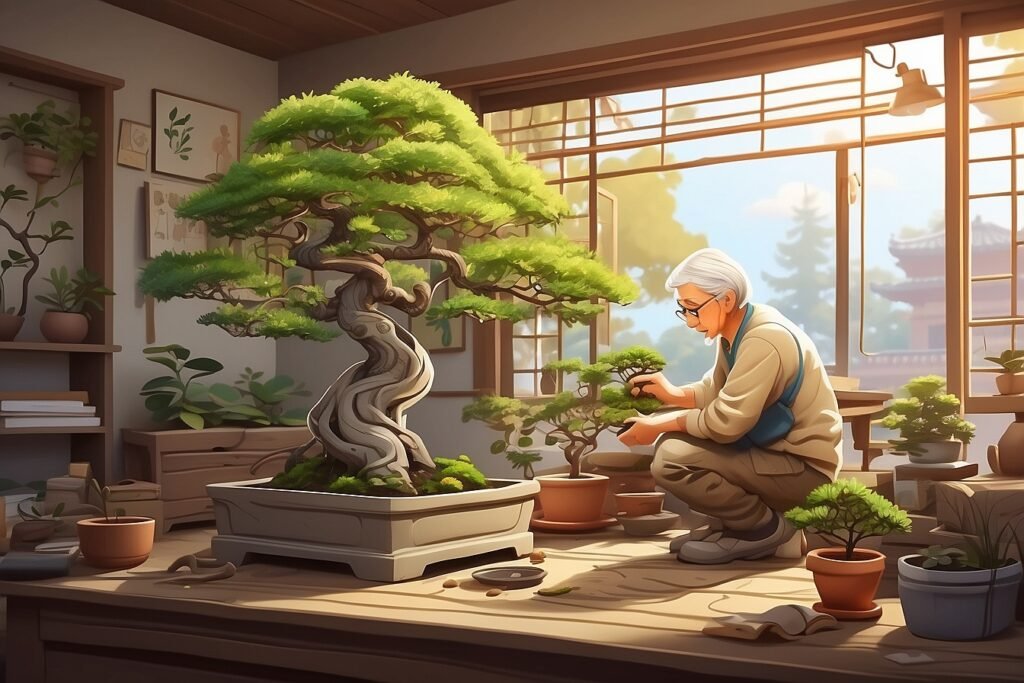Brief Overview of Ficus Benjamina
Ficus Benjamina, or Weeping Fig or Benjamin Fig, is a popular bonsai species. It belongs to the Ficus family, which has 80 to 200 species, but this variety is widely used in homes and offices.
Ficus Benjamina is a tree native to Asia and Australia. It can grow up to 30 meters tall in its natural environment but can be pruned and cared for as a bonsai to reach a height of up to 10 feet (3.05 m). It has droopy branchlets, shiny oval leaves, and a beautiful umbrella-like shelter.
Ficus Benjamina is charming and purifies indoor air by removing toxins like formaldehyde and xylene.
Understanding Ficus Benjamina

Characteristics of Ficus Benjamina
Did you know that the leaves of the Ficus Benjamina plant change colour and texture as it grows? And it’s not just that – this unique plant also has three types of flowers: male, fertile female, and sterile female! No wonder it’s become such a popular indoor tree species worldwide, especially as a bonsai plant.
If you’re looking for a bonsai plant that is perfect for beginners and seasoned gardeners, Ficus Benjamina is a great choice! Not only is it adaptable to different environments, but it also grows quicker than other Ficus species. To care for this beauty, you must ensure it gets shelter from direct sunlight, high moisture levels, and humidity.
It loves bright and sunny lighting but can also adjust to shade. Just remember to water it moderately in summers and less in winters. It’s sensitive to cold drafts, so keep it protected. Give it long days and high temperatures, and it will blossom!
The Unique Appeal of Ficus Benjamina Bonsai
You can style it differently, such as Formal and Informal Upright, Cascade, Literati, Broom, or Slanting. You can also use it for Rock-over-Roots and Clasped-to-Rock type plantings!
To keep your bonsai in shape, it’s essential to prune it regularly. Ficus Benjamina responds well to wiring, allowing you to train it into any desired style. Additionally, you’ll need to report it yearly for the first few years to support its growth.
Your Ficus Benjamina bonsai will need a constant supply of fertilizers to thrive. They may suffer from diseases such as leaf loss, yellow leaves, white blisters, and whiteflies. But don’t worry; with proper care and attention, you can ensure your Ficus Benjamina bonsai remains healthy and vibrant!
Essential Care for Ficus Benjamina Bonsai

Ideal Environmental Conditions for Growth
If you have a Ficus Benjamina bonsai, I’m here to help you take good care of it. Understanding its environmental needs is critical to ensuring optimal growth for your bonsai. First, this plant thrives in high moisture levels, perfect for placing in areas like the kitchen or other spaces with high humidity.
Protecting your Ficus Benjamina bonsai from breezes and sudden temperature changes is essential because it’s sensitive to cold. This plant is best suited for warm climates, so if you’re in USDA plant hardiness zones 10 to 11, you’re good to go!
Watering your bonsai can be tricky, but I will guide you. During summers, your bonsai will need moderate watering, while in winter, it requires less. Overwatering can lead to root rot and other diseases that harm your plant’s health. So, make sure you do everything correctly!
Importance of Sunlight Exposure
You would be happy to know that it is quite a resilient plant regarding lighting. Although it loves bright and sunny spots, it can quickly adapt to shade. However, it’s best to shield it from direct sunlight to keep it healthy and prevent its leaves from dropping.
One way to strike a perfect balance is to place your bonsai in an area that receives filtered sunlight. This will give your plant the light it needs to thrive without the risk of damaging its delicate leaves. I hope this helps!
Handling Seasonal Variations in Care
When the temperature drops below 60 degrees Fahrenheit, it’s time to move your bonsai indoors. Remember that Ficus Benjamina is cold-sensitive and may experience leaf loss if exposed to low temperatures.
You may notice some leaf loss after transplant shock or significant changes in light intensity, but don’t worry! With proper care and patience, your Ficus Benjamina bonsai will quickly return to its lush self.
The Art of Pruning Ficus Benjamina Bonsai

Role of Pruning in Promoting New Shoots
Here are some helpful tips on taking care of your Ficus Benjamina bonsai. One important activity is pruning, which helps keep your plant in shape and size and encourages new shoots to grow.
Additionally, pruning helps control the direction of growth and promotes overall plant health. Remember to give your bonsai some love and care through regular pruning!
Techniques for Maintaining Shape and Optimal Growth
Several techniques can help you maintain the shape and promote optimal growth of your Ficus Benjamina bonsai. Here’s a quick guide:
- Selective Pruning: Removing branches or leaves that don’t fit the desired shape is essential to shape a bonsai. This requires precision and a clear vision.
- Pinching: Pinching is a pruning method done with fingers to remove new growth and maintain the bonsai’s shape.
- Leaf Trimming: To promote balanced growth in bonsai, remove leaves to allow light to reach the inner parts.
- Defoliation: Remove leaves during the growing season to encourage smaller, proportionate leaves. Use sparingly and only on healthy trees.
- Wiring: Wiring with aluminium or copper wires can shape branches and trunks, and it complements the effects of pruning, although it’s not a pruning technique.
Steps to Train Your Ficus Benjamina into an Elegant Bonsai Form
Follow these simple steps to train your Ficus Benjamina into a beautiful bonsai tree. We’ll explain everything you need to know.

- Propagation: Use stem cuttings or direct saplings for propagation.
- Preparation: Use a regular terracotta training pot and mix river sand, Vermicompost, and crushed bricks to make the potting medium.
- Light and Water: Place the bonsai in partial sunlight and water it regularly to maintain optimal moisture levels.
- Pruning: Regular pruning encourages new branches and helps maintain the desired shape and size of the bonsai.
- Styling: Choose a bonsai style that suits you. The options include Formal and Informal Upright, Cascade and semi-cascade, Literati, Broom, or Slanting.
- Wiring: Use aluminium or copper wires to mould the bonsai according to your desired style.
- Repotting: Repot the plant yearly using well-draining soil for the initial years. During this process, prune about one-third of the roots.
- Post-repotting Care: After repotting, keep the plant in the shade for 15 days and continue regular watering.
- Fertilization: Provide a constant supply of nutrients using a balanced fertilizer weakened to half the strength.
- Protection: Shield your bonsai from extreme changes in light, temperature, humidity, and movements.
- Pest Control: Regularly inspect the plant for insect infestations and treat them accordingly. Look for leaf loss, yellow leaves, white blisters, and whiteflies.
Protecting Your Ficus Benjamina Bonsai from Diseases
Even though Ficus Benjamina bonsai is known for its resilience, it’s not entirely immune to diseases and pests. Here’s how you can protect your bonsai:

Regular Inspection
Inspect your Ficus Benjamina bonsai regularly for signs of diseases or pests such as yellow leaves, leaf loss, white blisters, and whiteflies. These could indicate an infestation or disease.
Correct Watering Practices
Water your plants appropriately to avoid issues. Overwatering causes root rot, while underwatering stresses the plant and makes it more prone to diseases.
Proper Fertilization
Use a balanced fertilizer diluted to half the strength to provide a constant supply of nutrients. Adequate nutrition helps the plant fight off diseases and pests more effectively.
Pest Control
To eliminate pests in Ficus Benjamina, use a suitable pesticide such as mild insecticidal soap or neem oil. Scale, mealybugs, and spider mites are common pests that can be treated with these remedies.
Disease Control
If you see leaf spots on your Ficus Benjamina, it may have a fungal disease. Apply a suitable fungicide and improve the plant’s growing conditions to address the problem.
Frequently Asked Questions (FAQs) about Ficus Benjamina Bonsai care:
What type of soil is best for my Ficus Benjamina Bonsai?
A well-draining bonsai soil mix is essential for your Ficus Benjamina. You can prepare a potting medium mixture of river sand, Vermicompost, and crushed bricks.
What tools do I need to care for my Ficus Benjamina Bonsai?
Essential tools include pruning shears for trimming and shaping, wire for styling, and a watering can for maintaining moisture levels. When repotting, you’ll need a root hook to remove the plant from its pot carefully and a root rake to untangle and trim the roots.
How often should I fertilize my Ficus Benjamina Bonsai?
Regular fertilization is critical to the health of your bonsai. Use a balanced fertilizer diluted to half the strength for a constant supply of nutrients.
What are some common diseases that can affect my Ficus Benjamina Bonsai?
Ficus Benjamina can be susceptible to pests like mites, mealybugs, scale insects, and whiteflies. Regular inspection and prompt action can prevent these issues. If you notice signs of disease or infestation, use a mild insecticidal soap or neem oil as a first step in pest control.
How often should I repot my Ficus Benjamina Bonsai?
For the initial years, repot the plant annually using well-draining soil. During this process, prune about one-third of the roots.
Can Ficus Benjamina Bonsai be grown indoors?
Yes, Ficus Benjamina Bonsai is an excellent indoor plant. It adapts well to various light conditions but prefers bright, indirect sunlight.
Concluding Thoughts
Learn how to care for your bonsai plant with our expert tips. We’ll teach you how to provide the right conditions, including sheltering from direct sunlight and maintaining high moisture levels. You’ll also learn how to navigate the challenges of caring for a slow-growing plant, including regular pruning and potting in well-draining soil. We’ll help you identify and tackle any pests or diseases that may arise. Start your bonsai cultivation journey today and experience the joy of nurturing a living piece of art.
Further Reading and Resources
- The Enigmatic Allure of the Black Spruce Bonsai: A Comprehensive Guide
- Mastering the Art of Japanese Black Pine Bonsai: A Comprehensive Care Guide
- The Ultimate Guide to Norfolk Island Pine Bonsai Care: Expert Tips and Techniques
- Mastering the Art of Growing Birch Bonsai (Betula): A Comprehensive Guide
- Alberta Spruce Bonsai: A Detailed Guide to Pruning, Growth, and Maintenance
- The Comprehensive Guide to Caring for Your Mugo Pine Bonsai





